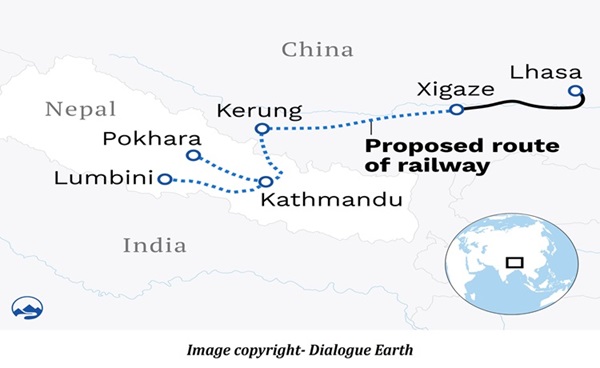The Nepal-China Trans-Himalayan Railway Project, which was proposed under China's ambitious Belt and Road Initiative (BRI), is taking shape on the ground. This 170 km long high-altitude rail link project will connect Tibet's Kyirong (Gyirong) to Nepal's capital, Kathmandu. Its estimated cost is calculated to be $2.75 billion dollars..
After the implementation of the new constitution in Nepal in 2015, there were prolonged violent agitations in the Terai region, and the India-Nepal border was completely closed by the Madhesi community. This directly affected the shortage of daily essential commodities exported from India to Nepal, including petrol, LPG cylinders and life-saving medicines. The Nepal government believed that this "unofficial economic blockade" was sponsored by the Indian government to put pressure on Nepal.
However, trade between the two countries has grown since 2015. Nepal and India are currently working to improve existing transit routes and open new transit points. Despite this progress, there has been a long-standing sense of mistrust between Nepal and India over transit routes, which had been further aggravated by the economic blockade in 1989 and 2015. Only three months after the unofficial economic blockade, the then Prime Minister KP Sharma Oli went to Beijing to look for alternative ways for Nepal's transit route. In this regard, bilateral talks were held on wide-ranging issues and for the first time, the Trans-Himalayan Rail Project was outlined in the Joint Statement in March 2016. During his second visit in 2018, an MOU was signed between the two countries, and this railway project was given a green signal. In 2018 only, the Chinese Railway Engineering Department team conducted a preliminary survey for the rail project. It was clearly anticipated that the proposed rail project would pass through wildly inaccessible areas, and due to high altitude and seismic areas, 95% of the total rail track will be based on tunnels. To get more straightforward and accurate information about the track, Chinese authorities started an aerial feasibility study in early 2023, and an in-depth feasibility survey was proposed for which China allotted ¥180 million money.

From the above discussion, two main points are clear: cutting-edge expertise will be required for the construction of the rail track, along with technical superiority, and the cost of track construction will also be significantly high. However, more important than both these points is the question of how beneficial will be the use of this high-altitude, high-cost railway track for Nepal. According to the Nepal Rastra Bank, the total trade between Nepal and China in the financial year 2022-23 was $1.791 billion dollars. The trade imbalance between the two countries is very high, with Nepal exporting only $11 million dollars of goods and services to China and importing $1.78 billion dollars. In this context, The Nepali Congress leader and former Union Minister Minendra Rijal's remark becomes very relevant: "What will we export to China and what will we import from Tibet through the railroad? So, let's build roads instead."
Some Nepali experts in India believe that this rail track is not being built for Nepal-China trade but by China with the Indian market in mind. Also, these experts believe that Nepal will be economically unable to cross inaccessible areas like the Himalayas to send its products from its Terai region, where Nepali industrial units are concentrated, to Tibet. It is worth noting that Tibet is the world's highest plateau, with an average height of 4,500 meters, and it is a sparsely populated area with negligible consumption potential. Therefore, it is obvious that Nepal will have to send its exports to the main Chinese markets, where they can be consumed. Secondly, if Nepal wants to export goods anywhere in the world via Tibet, it will have to develop access to port cities like Shenzhen, Lianyungang or Zhanjiang in China, which have an average distance of 3,300 kilometers from Kathmandu. On the other hand, the nearest port in India is Kolkata, which is only 890 kilometers away. In both scenarios, Nepali goods will eventually face an economic burden, and as a result, Nepali goods will no longer be economically competitive.
At the conference organized by the Nepalese think tank Center for Social Inclusion and Federalism (CESIF) in 2023, experts mainly raised the issue of why the Oli government is not developing the six already established road-based transit points for Nepal-China trade. This will be in Nepal's best interests not only economically but also geographically. It is known that the Trans Himalaya Rail Link Project will pass through the youngest fold mountains in the world, which have been marked as earthquake-prone zone-5. High-intensity earthquakes are very likely here, and any construction work in this area can pose a threat not only to Nepal-China but also to other South Asian countries. It was also said at the conference that Nepal's role in the feasibility survey currently being conducted is minimal. There is also the question of availability of railway engineers in Nepal as the Nepal Railway Department was established just a decade ago. Questions also arose as to how Nepal would audit the estimated cost of the project by China without technical expertise and understanding.
The Trans-Himalaya Rail Link Project has become a matter of controversy from the very beginning. From 2018 till today, there has been no agreement between the two countries on which model the project will be constructed. Will the amount provided by China for this project be a loan or a grant, and if it gives such a huge amount to Nepal like a loan, then what will be its terms and interest rates for the same? There is a high possibility that this project will also turn out to be a white elephant like Pokhara International Airport or Hambantota International Port. If such a situation arises, the strategic equations will change rapidly in South Asia.
Apart from all these things, China has declared a 0% import duty on 95% of Nepal's goods to encourage Nepalese exports in its markets. However, how much an agricultural economy like Nepal will be able to benefit from this exemption is in the lap of the future. As is known, Nepal currently exports only $11 million dollars’ worth of goods to China, which is like zero in China's total imports. Yet, it is difficult to say for how long China's 0% import duty policy towards Nepal will continue.
Based on the above discussion, it can be said that the Trans Himalayan Railway Project will not only be a high-cost and high-altitude project, but it is likely to be a high-risk project. The biggest challenge before Nepal is going to be increasing its exports so much that this transit route can prove its relevance. Also, providing access to a big power like China across the Himalayas can become a big security issue for Nepal and India from a strategic point of view. Using this route, China can not only transport its army and heavy military machinery to the Indian border in a short time but from an economic point of view, it can flood the Indian markets with its goods. India must necessarily examine these issues with Nepal, and both countries should develop a mutual understanding concerning the project's viability.
At present, not a single Nepali railway engineer is enrolled in the Indian Railway Engineering Training Institute, while some top railway officials of Nepal are undergoing training in China to gain more understanding related to railways. India, Nepal and Japan can work together in the field of railway technology. The Trans Himalayan Railway is still in its initial stages, so the Nepal government should once again consider the relevance of this project. It is possible that in order to counterbalance India, Nepal may put its national security at risk through this Trans-Himalayan Railway project.
(The paper is the author’s individual scholastic articulation. The author certifies that the article/paper is original in content, unpublished and it has not been submitted for publication/web upload elsewhere, and that the facts and figures quoted are duly referenced, as needed, and are believed to be correct). (The paper does not necessarily represent the organisational stance... More >>
Image Source: https://cdn.pixabay.com/photo/2012/10/25/23/18/train-62849_960_720.jpg











well-researched piece
Post new comment